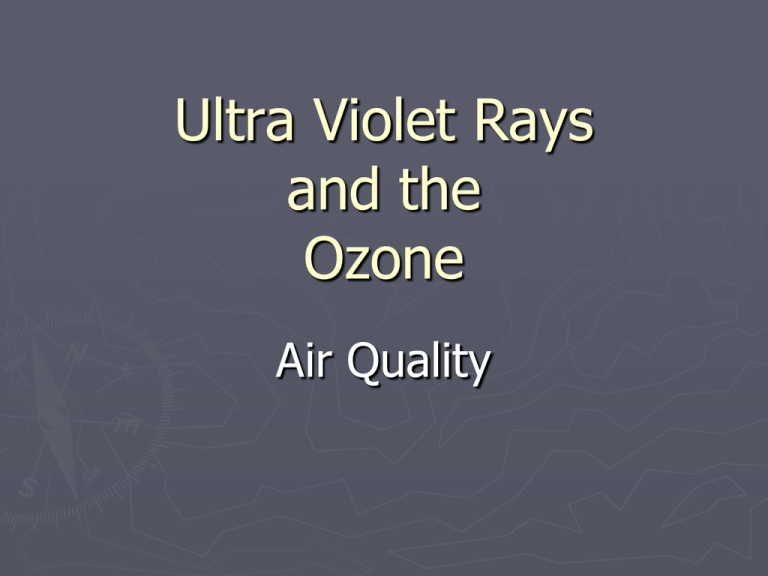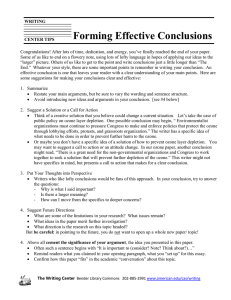Ultra Violet Rays and the Ozone Air Quality
advertisement

Ultra Violet Rays and the Ozone Air Quality Define Ultra Violet ► Light beyond the visible range of human vision, at the short end of the spectrum. It occurs naturally in sunlight; it burns and tans the skin and converts precursors in the skin to vitamin D. Prolonged or excessive exposure to ultraviolet light can damage the skin and increase the susceptibility of the skin to cancer. Not for Humans Only ► We are particularly concerned by the potential impact of increased UV radiation on plants and animals, simply because they form the basis of our food supply. Significant changes in the health or growth of plants and animals may reduce the amount of available food. Aquatic wildlife is particularly vulnerable ► Phytoplankton are at the start of the aquatic food chain, which account for 30 per cent of the world’s intake of animal protein. Phytoplankton productivity is restricted to the upper layer of the water where sufficient light is available. A small increase in UV-B exposure could significantly reduce the size of plankton populations, which affects the environment in two ways. First ► With less organic matter in the upper layers of the water, UV radiation can penetrate deeper into the water and affect more complex plants and animals living there. Solar UV radiation directly damages fish, shrimp, crab, amphibians and other animals during their early development. Furthermore less plankton means less food for the animals that prey on them and a reduction in fish stocks, already depleted by overfishing Second ► Furthermore, less plankton means less food for the animals that prey on them and a reduction in fish stocks, already depleted by overfishing U.V. From the Sun Molecular Comparison Single Oxygen Atom Oxygen we breathe Ozone molecule Chemical Formula Earth’s “Good Ozone" Is in the Stratosphere Earth’s “Bad Ozone" is in the Troposhpere near the Earth’s surface What does the Ozone do? ► It filters out and reduces most of the ultraviolet from the sun's radiation. ► Ozone absorbs 99% of the harmful ultraviolet (UV) radiation. ► Lower, in the troposphere, ozone is a component of smog, and is responsible for breathing difficulties and other ailments. What Causes Ozone Depletion ►CFC ---- chlorofluorocarbon. Freon Refrigerants Aerosol-spray propellants Solvents Foam-blowing agents Styrofoams CFC Deplete the Ozone Causes Holes in the Ozone Layer Conditions that would result in a high amount of UV ► Noontime ► Anytime ► Low in summer. the Sun is high in the sky. cloud cover. ► Reflective ► Being ground cover like sand or snow. at high altitude or closer to the Sun. Effects of UV on Humans. ► cause tans and sunburns after a short while ► it can cause wrinkles ► faster photo aging ► different types of skin cancer. ► malnutrition / starvation since our food crops are similarly attacked ► Effects and Damages DNA in all living things Ways to protect yourself from UV radiation ► Sunscreen ► Sunglasses with UV protection ► Hats ► Clothing ► Use Umbrellas in the Sun ► Reduce CFCs to protect the Ozone ► Stay inside ► Stay out of the sun between 11 AM & 3 PM ► When outside stay in the Shade . What type of UV radiation does most sunscreen protect against? . ► UV-B. Some sunscreens also protect against UVA, but, in general, all sunscreens protect against UVB which is the most dangerous. Clouds completely block out UV radiation. T or F ► False, clouds can block some but not all of UV radiation. Puffy clouds close to the sun can even lead to increased UV. The ozone layer can also be considered as the… ►. … Earth’s Sunglasses Antarctic View of Ozone 1970 - 2049 Antarctic Ozone Hole 1981 - 1990 Antarctic Ozone Hole 1996 - 2015 What is an Ozone Alert? ► When air quality is unhealthy due to a high level of particle pollution and/or ozone. ► Ozone is a toxic air pollutant that is a concern for people's health when levels in the outdoors are high. ► Hazey Days? Smog = Smoke and Fog A Global Concern What are the levels of an Ozone Alert? Recommended precauctions to take during the various levels of an Ozone Alert? Green Alert Safe levels for most groups Yellow Alert Moderate levels, be wary Orange Alert ►An orange ozone alert mean it is unhealthy outside for sensitive groups -- including active children and adults with respiratory problems like asthma. Red Alert ►A Red ozone alerts mean everyone should limit outdoor activity, especially children, the elderly and the infirmed. Purple Alert ►Purple ozone alerts are considered very unhealthy. Everyone should limit outdoor activities and people with respiratory problems should stay inside. Maroon Alert ► Hazardous to all living things, plant, animal and bacteria Aerosols/Particulates Fire and Volcanos How to be informed of Ozone Alerts ► News and Weather Broadcasts ► Signs posted in Recreational Areas such as parks and athletic fields ► Internet Actions to reduce ground level Ozone ► Controlling of auto emissions Eliminate excessive engine idling Ensure automotive exhaust system functions properly Avoid unnecessary driving whenever possible Don't refuel until after 6:00 pm Take public transportation (Some cities provide free bus service on Ozone Action Days). ► Limit the use of lawn mowers and outdoor grills to after 6:00 pm ► Limit the use of aerosol cans around the home (for example, hair gel instead of hair spray) Research ► Top three best countries for air quality. ► Worst three countries for air quality. ► Where does the United states stand in air quality with other countries. ► Top three best states for air quality. ► Worst three states for air quality. ► Where does North Carolina stand with the other states. ► Where dose Statesville stand with the other cities in North Carolina ► Brief: What makes air quality good and bad and who and what is WHO.




